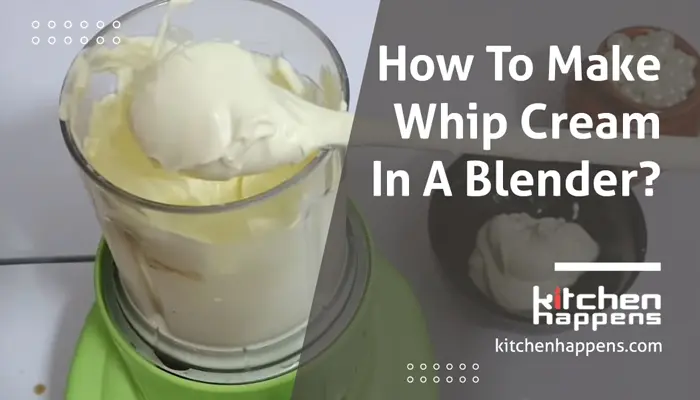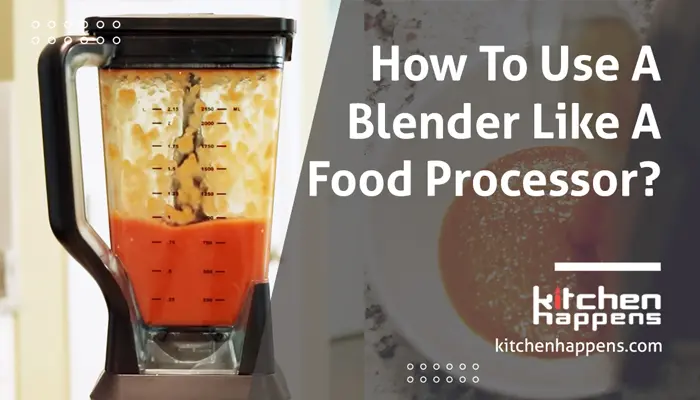Food processors are now one of the most helpful kitchen appliances, and that’s why every cook loves to have them in their kitchen. However, some people still don’t understand this gadget’s mechanism and usage.
Some even have the misconception that a food processor is the same as a blender. But, of course, that’s not true.
Now, if you are planning to buy a food processor or already have one, you can get to know its ins and outs by learning about its different parts and attachment. Understanding each part of the food processor will help you to know which part goes where and how exactly each part works.
So, if you ever wonder about any of these, you will get your desired answer here. I will introduce you to the food processor parts list, their usage, which part is replaceable, and many more unknown things.
But first, let me briefly introduce this revolutionary kitchen appliance, as you may not be familiar with it much.
Definition & Functions of A Food Processor
A food processor is a multifunction kitchen tool that can effectively chop, shred, slice, and puree almost any type of food. Some models can also help you with the tasks like juicing fruits and vegetables, kneading dough, making cake batter, beating egg whites, and grinding meats.
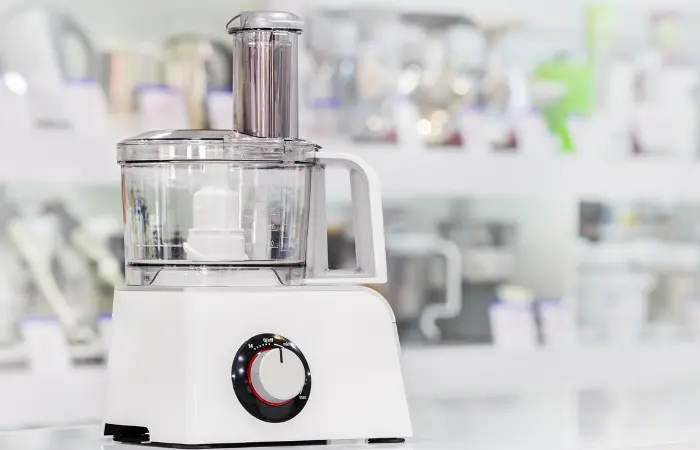
With this appliance, tasks that were once time-consuming and hard to do by hand are now a matter of moment. Using it is one of the best ways to shred cabbage, grate hard cheese, knead stiff dough, chop raw carrots, and many more.
The food processor was first offered on the North American market in 1973 by engineer Carl Sontheimer. Consumers didn’t fully grasp the new device’s potential for a few years, but once they did, the food processor quickly rose to popularity.
And now that everyone knows its usage, almost everyone tries to have a food processor for daily convenience in preparing food.
Well, now that you have a short introduction to this appliance, it’s time to learn about the main parts of a food processor.
Basic Food Processor Parts List
The answer to the question of what are the parts of a food processor may vary according to design, model, brand, and size.
Modern food processors have three standard sizes: full, compact, and mini. Regardless of the brand and different options in design, the basic parts of food processors are a motor base, a working bowl with a lid and feed tube, and a collection of attachments.
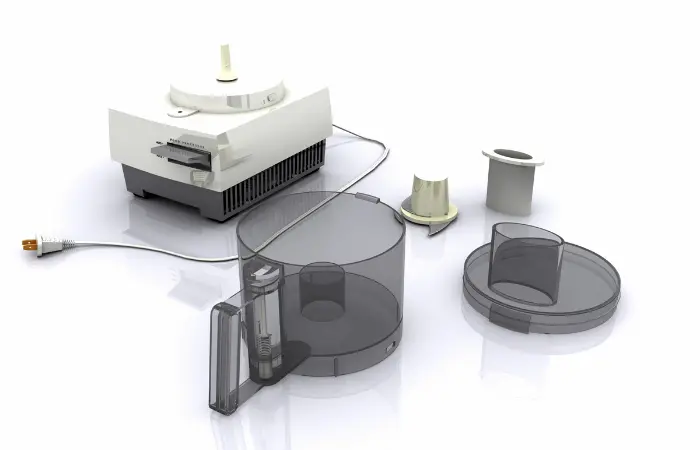
You may find the parts easy to understand at first as they resemble a blender. Right?
Well, even though they sound similar, the functionalities are quite different in many ways. So, here are descriptions of all the main parts to give your proper insight.
Motor Base with Control
The heaviest part of a food processor is the motor base. It houses the motor and provides support to the work bowl and the other upper parts. Also, the motor base is in charge of supplying the power required to perform various food processing tasks.
The base also gives weight so the food processor won’t move too much when operating. And it also houses all the other electronic parts.
You can’t operate your food processor to perform any tasks without the motor. So, it’s one of the most important parts. Without it, all the other food processor parts are almost useless.
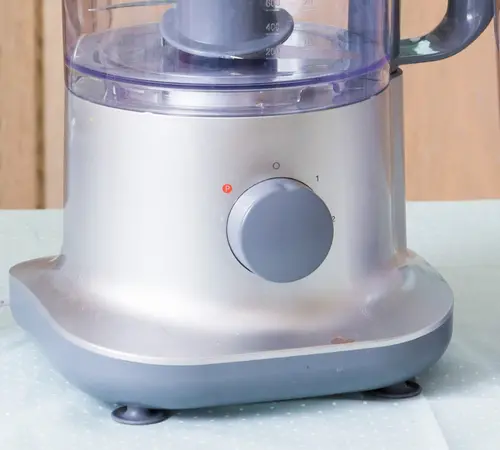
Despite the fact that the early food processor bases were solely made of hard, white plastic, modern models come in a variety of fashionable colors and have both metal and plastic finishes, ensuring that your equipment will match your kitchen’s design.
Besides the motor, the base also houses all the controls.
Although these controls can differ from one food processor to another, the basic ones are all the same. Typically they contain a power button, one button (or more) to operate the food processor, and a pulse button.
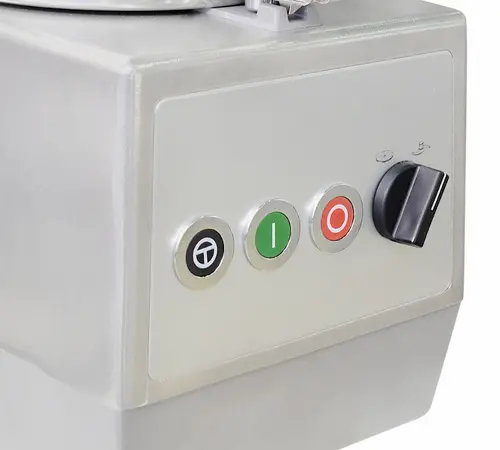
The power button serves the simple purpose of turning the device on and off. Additionally, a button (or numerous buttons) can be used to turn on the motor and process the food.
In some models of the food processor, there are speed settings that control the speed of the blades. Others include a speed dial that you can manually turn to adjust the speed.
On the other hand, when you push the pulse button, the food processor will operate at its highest speed and will immediately stop once you remove your finger from the button.
The pulse button is most effective when you want more control over how finely the ingredients should be chopped. For instance, if you like roughly chopped vegetables rather than the puree texture, you may use the pulse button to achieve the desired chop gradually.
Okay, let’s move on to another main part of a food processor: the work bowl.
The Work Bowl
The work bowl is the part where all your ingredients are processed. This is where you put your blades and other attachments. Usually, the bowl is transparent, and you can see your food processing inside.
The bowl sits on the motor base and locks into the shaft connected to the motor. It ensures that the bowl stays locked in place while the food processor is running.
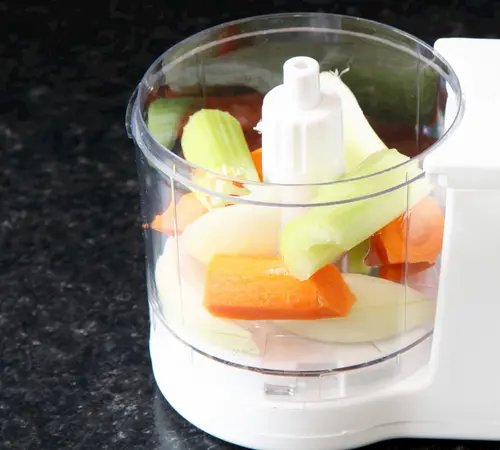
While talking about the size of the bowl, it may vary depending on your model and the machine’s size. The largest size has a capacity of up to 20 cups, while the smallest one typically holds 3 cups.
Lastly, there is a handle on the work bowl for user convenience.
Motor Spindle (Blade Or Disc Holder)
The motor spindle is the part which holds the blades and discs. Since the blades and discs are created to operate at different positions in the food processor’s work bowl, this part is specially designed to hold them at various heights.
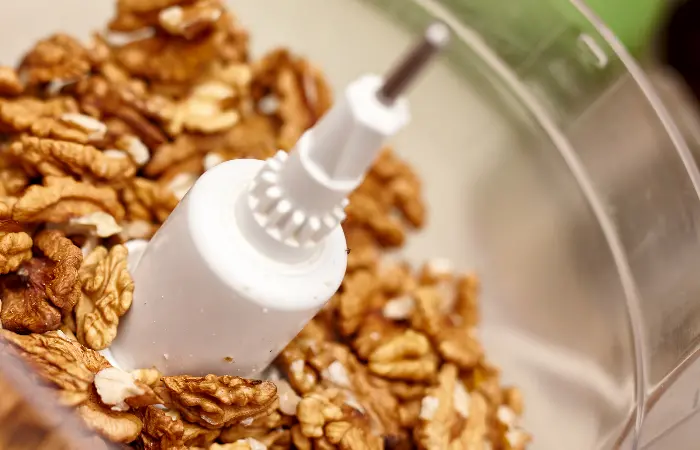
A Lid with A Chute And Pusher
The lid is for covering the top of the work bowl so that nothing spills while processing the food inside. There is a feed tube (also known as a food chute) in the lid that is used to feed various ingredients inside the processor.
The feed tube is essential when a blade is attached to the top of the bowl instead of sitting inside. So, when you need to put ingredients, you can easily put them through the feed tube, and your hands will always be safe from the blades.
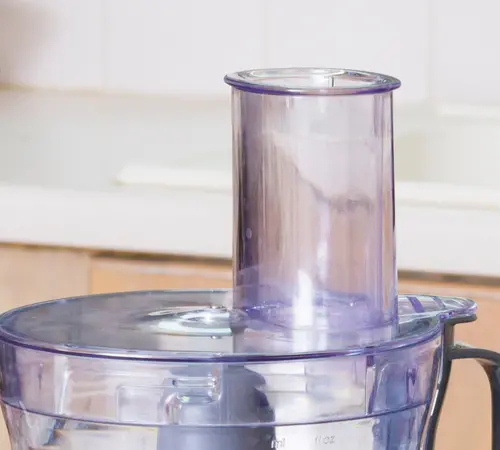
Depending on the type of food processor you own, the diameter of the chute often varies. Some are rather slim, requiring you to slice your foods to fit in the tube of the food processor, while others are wide enough to hold whole fruits and vegetables.
A pusher is included with the feed tube (sometimes called a plunger). You can push food through the chute with the help of this pusher.
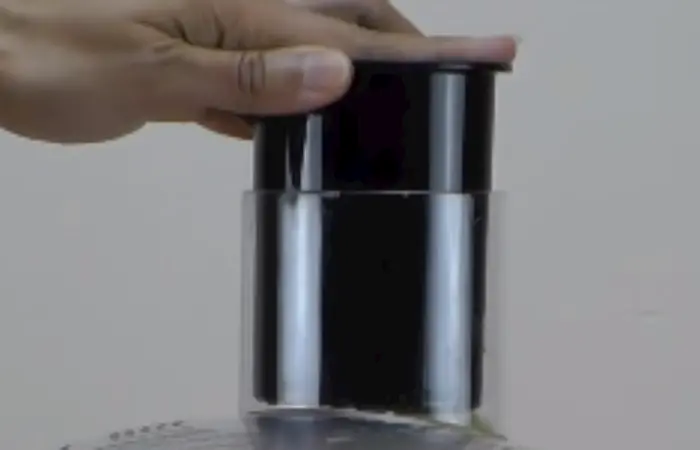
Some food processor brands include a citrus press, which is helpful for pressing different citrus fruits such as oranges, lemons, grapefruits, and others.
Different Blades And Disc Attachments
Well, if there is something that you can get confused about the most on the food processor parts, it’s their wide range of blades and disc attachments. Each of them has completely distinct functionalities.
The food processor’s blades are designed to handle all kinds of chopping. You can choose from several blades that should be suitable for various types of meals depending on the brand of food processor you have.
A standard food processor comes with at least three blades and discs—an s-blade, a slicing disc, and a shredding disc. You can buy extra attachments but make sure to check whether they are compatible with the specific brand of your food processor or not.
While some blades are designed to cut through soft fruits and vegetables, others are tough enough to chop hard roots, stems, fruits, vegetables and raw foods. Depending on the processor’s power, some cutting blades may also mince various kinds of meat.
While talking about the discs, they are exactly like blades but are often mounted at the top of the blade holder, allowing processed food to gather in the work bowl.
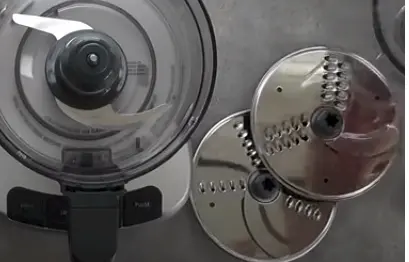
The slicing disc can cut cross-sectional slices of whole fruits and vegetables because they are designed to handle such items. On the contrary, the shredding disc can grate cheese, potatoes, carrots, and various other items.
Here, I only talked about the common blades and attachments. But there are more of them. Let’s discuss each type of blade in the next segment.
What Are The Different Types of Blades Available for A Food Processor?
Besides the blades that come with a food processor, many more attachments are available in the market.
The s-blade, slicing disc, shredding disc, grater disc, juicer, julienne disc and dough blade are among the most useful blades and attachments.
Now that you know about the most common and useful food processor blades and attachments, how do you choose which one to use?
Go through the following section to learn the usage of each blade and attachment in detail.
Detailed Usage of Different Blades And Disc Attachments
When shopping for a new food processor, it’s a good idea to determine the main foods you will use for processing. This will let you choose the appropriate processor blade and attachment type for your requirement.
So, here is what each blade and disc are for.
- S-Blade
The S-shaped blade on a food processor is perhaps the most popular blade. It has two curved blades that extend on opposite ends, creating the expected “S” shape. They are used for slicing, chopping, grinding, grating, and mixing different ingredients, and that’s why these blades are the most widely used in food processors.
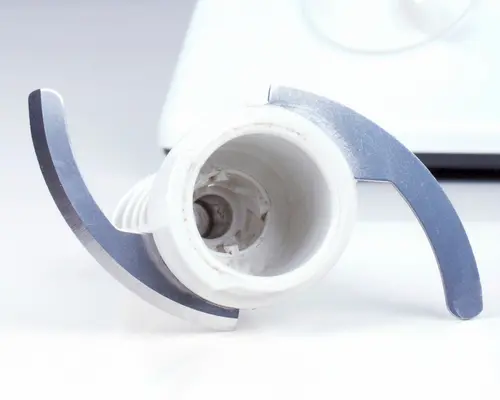
You can use them for various tasks, including making nut butter, chopping tomatoes for salsa, etc. If you don’t feel like pulling out your chef knife to chop the items with your hand, you may also set these blades and then use the pulse setting to do it.
- Julienne Disc
The julienne disc has tiny snake teeth-like blades. Their razor-sharp pointed edges are ideal for cutting ingredients into long, thin, straw-like shreds.
For instance, if you want to make vegetable sticks, handmade hash browns, or garnishes, julienne discs are unquestionably the right attachment to choose from.
Remember that, unlike the S-blade, any type of disc attachment rests on top of the working bowl rather than inside of it. While using discs, attach them to the shaft of the processor and insert food through the feed tube using the pusher.
You can use this disc to prepare non-cook squash pasta recipes. They also have the ability to cut spaghetti squash and zucchini into thin spaghetti-like strands.
- Shredding Disc
With the help of this disc, you can quickly and effectively shred carrots for carrot cake, broccoli for a crunchy salad, or cabbage for slaw. It is also ideal for shredding soft goat milk cheese as well as hard cheese.

- Slicing Disc
As the name suggests, these discs are used for slicing fruits and vegetables. When you push food down the chute, these blades will quickly slice the food into extremely thin, flat stripes.
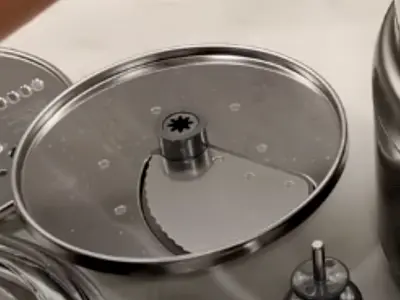
Some high-end food processors come with settings that let you make these slices as thick or thin as needed.
- Grater Disc
Unlike the two other discs mentioned, this one gives a very fine grate of your ingredients. You can easily grate cheese in the blink of an eye rather than wasting time while doing it manually.
- Plastic Dough Blade
Although you can use S-blade to knead the dough, this plastic dough blade is outstanding. It can better knead the dough because it has fewer curved paddles and is typically made of plastic rather than the sharp metal S-shaped blade, which may just cut into the dough.
So, next time, try using it for making pasta dough or even focaccia.
- French Fry Disc
One of the most famous staple foods in American cuisine is french fries. However, making them at home can seem like such a hassle, right?
When preparing for a large household, cutting potatoes can take a lot of time and can be challenging too. In such cases, a food processor with a french fry disc (or crimping blades) can definitely be helpful.
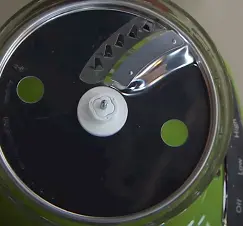
They make it possible to cut thin or thick french fry shapes evenly and speed up the process compared to hand-cutting the same shapes. These discs can also be used to cut vegetables for Asian meals or veggie pasta.
- Juicer
Two different types of juicer attachments are available, one is citrus, and another is non-citrus. The citrus one rests at the top of the processor and spins to juice your fruit.
On the other side, the non-citrus juicer is used to puree ingredients by collecting the pulp to leave the juice behind.
- Whipping Disc Blades
These blades are useful for making bases for desserts, sauces, and textures. You will also need this whipping disc to whip up fresh cream for baking a pie or a dessert.
You may also use them to make sauces, pesto, and butter from scratch. The amazing thing about these blades is that they may drastically reduce preparation time and save wrist and hand pain from manually whipping heavy liquids and bases.
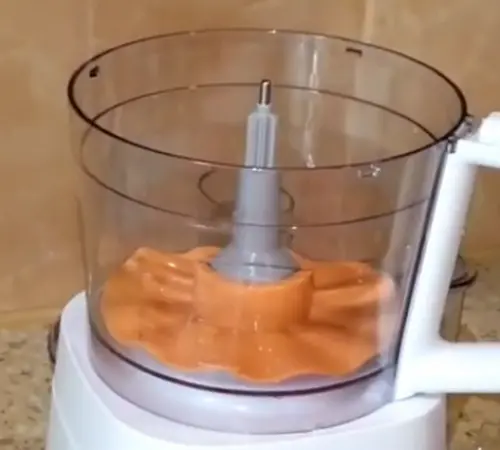
Anyway, except for the attachments I mentioned, there are many more, as manufacturers keep introducing them to make the different tasks easier. Yet, these are the most common and efficient ones that can do various meal preparation jobs.
So, now that you have a comprehensive idea about the different parts of a food processor, it’s time to discuss another important fact. Keep going to explore.
Is It Possible to Replace The Parts of A Food Processor?
A quality food processor is indeed quite pricey. So, it might worry you about what would happen if you accidentally misplace or break a part of it. Is there a way to replace it?
Yes, luckily, you can replace several parts of a food processor. Just search with your food processor model number to find any spare parts. There are different websites that sell replacement parts.
For example, Amazon has an excellent feature when you view a product. To ensure whether the part you are viewing fits your appliance or not, simply enter your model number in the search bar at the top of the product page.
Now, your main concern should be which parts are replaceable and which are not. In case you don’t know, my next part has your answer.
List of Food Processor Replacement Parts
Almost every part of a food processor is replaceable except the motor base. So, you can replace your
- Work bowl
- Lid of the bowl
- Pusher
- All types of blades and disc attachment
- Blades and discs holder
- And all the other extra parts that come with your food processor.
In short, you don’t have to worry about any broken parts. However, if the motor base gets damaged, you can either fix it or buy a new food processor.
Wait, wait, there are exceptional scenarios too! There are a few models of food processor that even offer replacement motor bases. So, I suggest you search whether your specific model’s replacement base is available or not.
Anyway, it’s time to wrap up this topic.
Closing Words
Hopefully, our write-up on the food processor parts list helped you gain the necessary knowledge.
Remember that there are numerous food processor brands and models, and all of them use the same standard parts. But some of them also offer a wide variety of extra parts.
When purchasing one, be sure to ask as to what additional components are included and whether or not they will be able to perform the necessary number of functions.
Frequently Asked Question
Are food processor parts dishwasher safe?
The bowl, blade, and lid are usually dishwasher safe, but you should still check your machine’s manual to be sure. However, it is recommended to wash them in the top rack of the dishwasher.
And for the other parts, like blades and discs, it is best to wash them by hand.


